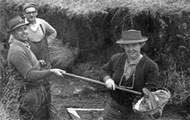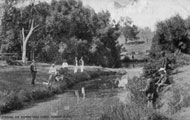- Swimming
- Interview :: Mick Munroe
- Interview :: Andrew Jennings
- Boating
- Interview :: Bob and Carol Lewis
- Interview :: John Southwood
- Object :: Kayaks
- Object :: John Southwood's Kayak
- Object :: Olympics Blazers
- Fishing
- Interview :: Kevin Laughton
- Object :: Brown Trout
- Object :: Fly Lines
- Object :: Fishing Rods
- Object :: Golden Perch
- Object :: OTAS Memorabilia
- Parks, Gardens and Fountains
- Interview :: John Chappell
- Object :: Water Stress Sculpture
Fishing & Orange Trout Acclimatisation Society
Today fishing is less about food for the table, than a chance to get into the bush, relaxing, enjoying nature, being absorbed in the moment and trying to fool a trout into taking a fly. Fishing is one of the most popular water recreations.
The first trout had been released in the Orange district in 1891. At the start of the Great Depression, on 16 February 1932, a group of enthusiastic recreational anglers gathered under the chairmanship of the Mayor of Orange, Alderman A W Blowes, and decided to form the Orange Trout Fishers' Club.
Summerhill Creek had already been identified as a suitable stream for brown trout (Salmo trutta), while Lake Canobolas and Spring Creek Reservoir were suitable waters for rainbow trout (Salmo gairdneri). At this time the popularity of fishing was putting pressure on indigenous fish stocks in the Central West so trout stocking was restricted to cold water close to Mount Canobolas.
Between 1926 and 1931, Bert and Len Collins liberated 2,500 trout in waters around Orange. NSW State Fisheries Department first stocking was in 1932 with the delivery of 3,000 trout fry in 50 cans that had been transported by rail to Orange. In the club's first year, 122, 000 fry were liberated at a cost of 7 shillings and 6 pence per 1000. Such was the enthusiasm that in 1933 club membership topped 131 but later it slipped back to 40. Several locals were involved in the propagation of trout when fry were unattainable from elsewhere, and the late Mrs Ella Stanford was recognised for her success in this respect. Stocking trout sourced from the NSW Department of Primary Industries' hatcheries continues to this day, as does the stocking of golden perch and silver perch in recent years.
In 1937, the NSW Government’s Fisheries and Oyster Farms Act provided for acclimatisation districts for trout and salmon to be declared, which is how the Orange Trout Acclimatisation Society (OTAS) gained its current name.


